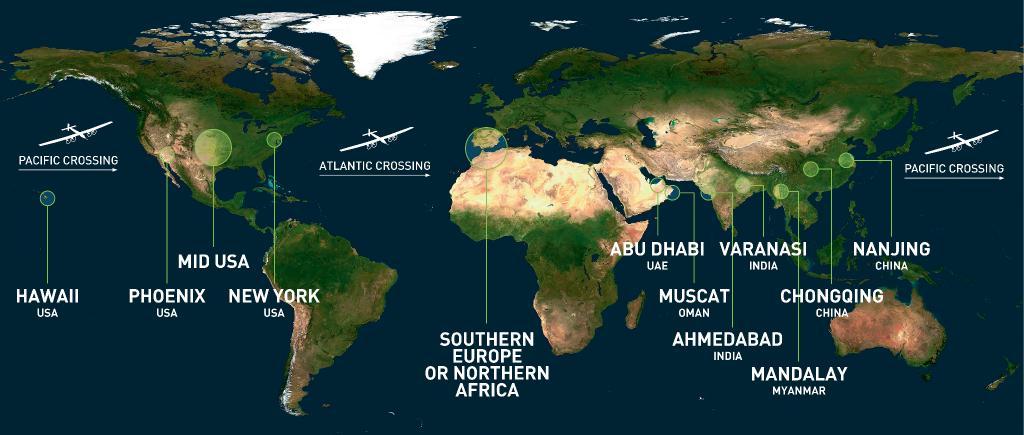
Bertrand Piccard and André Borschberg of Switzerland, who founded Solar Impulse, announced the flight path of Solar Impulse 2 during a press conference today in Abu Dhabi. The project’s latest plane will depart the capital of the United Arab Emirates in late February or early March and will return from this groundbreaking solar flight after flying around the world in late July or early August. The plane’s journey, which could take anywhere from 22,000 to 25,000 miles (35,000 to 40,000 kilometers), intends to fly day and night, 20 hours per flight, using only solar power--while sending a global message about the promise of clean energy and the need to confront the growing risks of climate change.
Solar Impulse has already made impressive history with the organization’s first prototype, which has flown across the United States, Morocco and Europe. The trips’ stops were opportunities for Piccard and Borschberg to evangelize Solar Impulse’s mission. But at a higher level, the two men, who are both engineers and pilots, have long emphasized the need to push the boundaries of renewable energy research and development. Next month’s round-the-world flight will promote their mission even further as they aim to reach out to governments, schools and local media during their upcoming journey—planned to both meet the challenges of geography while carrying out a very geopolitical strategy.
The first impression the plane makes is a reminder of what many have told Piccard and Borschberg since they conceptualized their vision over a decade ago: Their dream looks impossible. The plane has the wing span comparable to a 747 (236 feet, or 72 meters) yet weighs about as much as a family-sized car. Over 17,000 solar cells power four electric motors, which will rely on lithium batteries weighing 2,077 pounds (633 kg). The cockpit only has room for one pilot, which in part explains why the Solar Impulse 2 will take 25 or so flight days to travel around the world.
After takeoff from Abu Dhabi, the plane will stop in Muscat, Oman in order to position itself for the flight across the Arabian Sea where it will visit two cities in India. Piccard and Borschberg chose to stop in Ahmedabad in recognition of the city’s burgeoning clean technology sector; Varanasi, one of India’s oldest cities, serves as a symbol of how solar energy can transform lives and create economic opportunity in developing countries. From India the plane will continue to Myanmar, which the pilots said was important to recognize the country’s recent opening to the world. Solar Impulse’s final two stops in Asia are in China: Chongqing, which is industrializing rapidly as the country seeks to develop the nation’s interior, and then Nanjing. The duo will spend about a month in China as Piccard and Borschberg hope to use the media to spread clean technology’s potential to 80 million school-aged children.
The next leg, a five-day trip to Hawaii, presents not only technical challenges, but Solar Impulse’s biggest human challenges. High density thermal insulation is all what the pilots have to protect themselves from extreme cold and heat. The five or six days’ flights will be spent in a 41 square foot (3.8 m3) space that has only enough space for some physical exercise, oxygen, food and drink and survival equipment. After another long journey from Hawaii, Solar Impulse 2 will land in Phoenix to recognize Arizona’s rapid adoption of solar power. After a yet to be determined stop in the Midwest and New York’s JFK Airport, another long journey is planned across the Atlantic. Stops in southern Europe or Northern Africa will follow before the plane returns to its Middle East launch in Abu Dhabi.
Like past ventures in space travel, Solar Impulse’s attempt to circumvent the globe serves to demonstrate the future potential of new forms of energy technologies. The many partners who are vested in this project could also reap new opportunities in the future. For example, the chemical company Solvey has developed a composite of carbon fiber and paper to create a lightweight, honeycombed skin that allows the plane to shed weight. ABB has provided support with three engineers who are well versed in solar inverter and battery storage technologies. Google, Omega and Bayer Material Science are among the other companies that have supported Solar Impulse.
So of course we will not be gallivanting around the globe in solar powered planes, or cars, anytime soon. But pushing engineers and scientists to advance renewable energy technologies, while inspiring youth to consider a career in this sector, are more than a worthy enough outcome if Solar Impulse 2 completes its journey.
Based in California, Leon Kaye has also been featured in The Guardian, Clean Technica, Sustainable Brands, Earth911, Inhabitat, Architect Magazine and Wired.com. He shares his thoughts on his own site, GreenGoPost.com. Follow him on Twitter and Instagram.
Disclosure: Masdar covered Leon Kaye’s travel costs to Abu Dhabi Sustainability Week.
Image credits: Leon Kaye

Leon Kaye has written for 3p since 2010 and become executive editor in 2018. His previous work includes writing for the Guardian as well as other online and print publications. In addition, he's worked in sales executive roles within technology and financial research companies, as well as for a public relations firm, for which he consulted with one of the globe’s leading sustainability initiatives. Currently living in Central California, he’s traveled to 70-plus countries and has lived and worked in South Korea, the United Arab Emirates and Uruguay.
Leon’s an alum of Fresno State, the University of Maryland, Baltimore County and the University of Southern California's Marshall Business School. He enjoys traveling abroad as well as exploring California’s Central Coast and the Sierra Nevadas.














